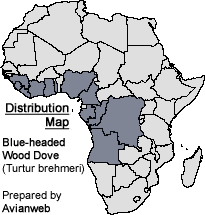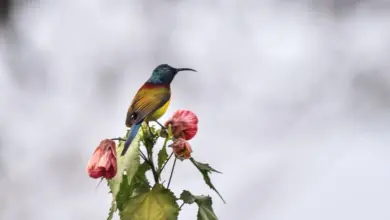Blue-headed Wood Doves
The Blue-headed Wood Doves (Turtur brehmeri) – also known as Blue-headed Doves or Madeira Doves – occur naturally in West Central Africa.
They are part of the Wood Dove family – bird genus Turtur – but differ quite substantially in appearance from the other members of this group. Blue-headed Wood Doves were formerly placed into their own genus Calopelia.
Distribution / Habitat
Blue-headed Wood Doves are widespread and locally common throughout their large range in west Africa, which stretches from the coastal forests of Sierra Leone east to the Cameroons, Rio Benito, French Congo and the northern Democratic Republic of the Congo (DRC), and south to Angola.
They are resident (non-migratory) with their range, and are commonly found near deserts, scrub and savannah.
They inhabit rain forests and occasionally secondary growth. They tend to avoid open areas.
These pigeons are usually seen alone or in pairs, but may form large flocks at waterholes or at favored feeding areas.
Suspecies, Ranges and Identification
- Turtur brehmeri brehmeri (Hartlaub, 1865) – Nominate Form
- Range: Southern Cameroon east through northern Congo to Rift Valley in eastern Democratic Republic of the Congo, and south to extreme northwestern Angola.
- Turtur brehmeri infelix (J. L. Peters, 1937)
- Range: Found along coastal Guinea and Sierra Leone east to coastal Cameroon, extending inland along rivers up to 80 miles (about 130 km)ID: The plumage is less “pinkish” on the upper chest and the wing spots are more metallic green than those of the nominate form.
Further Dove Information
- Dove Information
- Index of Dove Species
- Photos of the Different Dove Species for Identification
- Doves & Pigeons as Pets
Description
The Blue-headed Wood Dove measures about 10 inches (25 cm) in length, including tail. The plumage is mostly cinnamon-brown, except for the bluish-grey head (paler on the face), iridescent green wing patch, the bronze or golden glossy patches on the scapulars (shoulder feathers) and inner wing feathers, the mauve pink upper chest. There is a dark purple stripe from the bill to the eyes. The underwing feathers are chestnut colored.
The bill is dark publish red with a dull greenish tip.
The feet and legs are purplish red. The eyes (irises) are dark brown.
Flight: Their flight is quick and characterized by regular beats and occasional sharp flicks of the wings; and they generally fly low. In flight, the chestnut markings in the underwings are visible.
Gender ID: Males and females look alike.
Juveniles are duller than adults. They are scaly below and lack the wing spots.
Nesting / Breeding
Pairs are monogamous, establishing firm bonds that last a lifetime. They build nests out of twigs, leaves and other plant matter in trees (often acacias) or bushes. The average clutch consists of one to two cream-colored eggs. The male and female raise the young jointly to independence.
Diet / Feeding
Blue-headed Wood Doves mostly feed on various seeds (in particular grass seeds), fallen fruits, insects and small animals. Most foraging occurs on the ground.
Calls / Vocalizations
Their calls are described as a soft long coo-coo, followed by a series of slow descending coos lasting about 10 seconds, and ending with 4 seconds of rapid coos that decrease in volume.
Sound Recordings / Sound Recordings 2
Alternate (Global) Names
Chinese: ???? … Czech: Hrdlicka modrocelá, hrdli?ka modrohlavá … Danish: Kaneldue … Dutch: Brehmer-duif, Brehmers Duif … Estonian: sinipea-tuvi … Finnish: Kameruninuikuttajakyyhky … French: Émerauldine à tête bleue, Tourtelette demoiselle, Tourterelle à tête bleue, Tourterelle demoiselle … German: Blaukopftaube, Maidtaube … Italian: Tortora boschereccia testazzurra, Tortora testablu … Japanese: zuaobato … Norwegian: Blåhodedue … Polish: turkaweczka modroglowa, turkaweczka modrog?owa … Portuguese: Rola de cabeca azul, Rola-de-cabeca-azul … Russian: ??????????? ?????? ??????? … Slovak: bronzovka modrohlavá … Spanish: Paloma de Cabeza Azul, Palomita Cabeciazul … Swedish: Blåhuvad fläckduva



